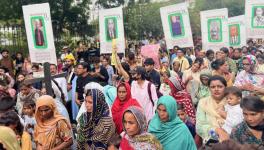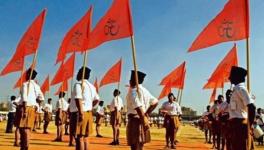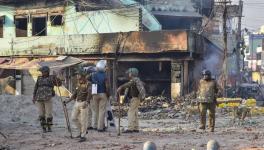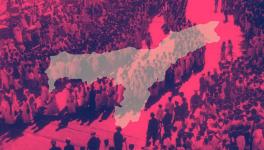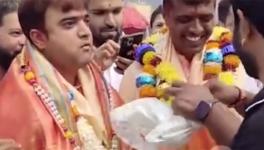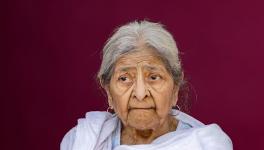Minnesota Massacre and Minority Rights Protection in Criminal Justice System: The Indian Story
On May 25, George Floyd (46), a member of the African-American minority community, was brutally murdered by a white policeman on a minor offence in Minneapolis, Minnesota, US. Floyd had lost his job in the wake of the raging COVID-19 pandemic. Public outrage over state violation of the norms of the criminal justice system led to mass protest movements in several parts of the US notwithstanding the havoc wrought by the pandemic. Sympathetic protest movements have erupted across Europe and elsewhere. Large-scale violence, arson, destruction of public property and face-offs with the police occurred in the US. Cries of ‘Black Lives Matter’ and ‘I can’t breathe’, the last words of the murdered Floyd, dominated the protest movements.
Amazingly, sections of the policemen themselves joined protest movements.A senior police official openly reprimanded US President Trump for talking out of turn.
The Minnesota massacre demands a sharp view on the need to protect and promote of minority rights in the criminal justice system. Systematic racial prejudice and structural police brutality mar the working of the police system in the US despite the existence of historically articulate and forceful leaders in the Afro-American community. The problem is long-standing and deep rooted and cannot be examined here.
I
In India, other factors including religion, caste, nation and ethnicity come into play in the performance of the colonially-inherited criminal justice system.
Crisis of governance over the violation of norms of minority rights in the Indian criminal justice system has existed for a long. Public protest on a mass scale emerged recently at a Delhi suburb, Shaheen Bagh, a remarkable sit-in peaceful protest, led by women against the passage of the controversial and discriminatory Citizenship (Amendment) Act in Parliament in December 2019.
|
Prelude Minority rights in the Constitution of India became an issue when the Citizenship (Amendment) Act, (CAA), 2019 was passed in Parliament. In 2016, the Joint Parliamentary Committee on the subject was warned by a constitutional expert that the legislation should omit any reference to religious communities and should refer only to ‘persecuted’ minorities. The law, as finally passed in 2019, controversially provided that ‘discriminated’ Hindus from Pakistan, Afghanistan and Bangladesh would be allowed to migrate to India but not Muslims. This provision falls foul of the Indian Constitution and has been taken up with the Supreme Court of India. Meanwhile, massive popular protest has taken place in different parts of the country including the Northeast where ugly violence occurred when the National Register of Citizens (NRC), allied to the Citizenship (Amendment) Act, was under preparation. Historically, Indian courts have been found to have had a ‘chequered history in tackling circumstances where they are ‘the final arbiter’. |
II
We begin by looking at the provisions of the Constitution in order to highlight the changes that are needed to protect and promote minority rights.
The persisting violence and crimes against the minority Muslims, Christians, Sikhs and the ‘national or ethnic minorities’ (UN term) in the Northeast and elsewhere in India poses a challenge to India’s largely unreformed criminal justice system, highlighting the need for appropriate modifications in the Constitution. Recent events in India have provided grim relevance to the subject.
Legal Framework and Key Concepts
The Preamble to the Constitution declares India to be a ‘secular’ state, which is of special relevance to religious minorities and seeks to secure to all ‘liberty of thought, expression, faith and worship’ and equality of status and opportunity.
Significant for the minorities is the elimination of inequalities ensuring their welfare as has been done for the weaker sections in the Constitution, besides the Scheduled Castes and Tribes. It should be the duty of citizens to promote harmony and the spirit of common brotherhood transcending religious, linguistic, regional or sectional diversities and preserve the country’s rich heritage and composite culture.
The Fundamental Rights in the Constitution, include among other things equality before the law; equal protection of the law; prohibition of discrimination on grounds of religion, race, caste, sex or place of birth; freedom to profess, practise and propagate any particular religion; freedom of religious instruction and worship and so on. These are essential for a multi-religious, multi-cultural, multi-racial society such as India along with communal harmony.
III
The Muslim, Christian and Sikh minorities have been victims of extrajudicial executions, torture, rape, intimidation, and implication in false cases, destruction of property and utilities and other illegal acts under the criminal justice system. Non-listed minorities in the Northeastern region too have been subjected to similar abuse.
In 1984, the Sikhs were subjected to genocidal killings after some Sikh members of the security forces assassinated former Prime Minister Indira Gandhi to protest the killing of Sikhs during and after ‘Operation Blue Star’. The genocidal killings of the Muslims in Gujarat in 2002 and the attacks on Christians in Kandhamal, Odisha in 2008, also violated the norms of the criminal justice system.
IV
There are no specific protective legal provisions for the minorities in the Constitution. Police, prosecution and the judiciary are not sensitised to minority issues and function within the existing colonial framework of law and order.
International principles and standards on minority protection are yet to be incorporated in the Indian criminal justice system.
The Constitution of India, 1950, does not define minorities. It refers generally to ‘minorities’ and speaks only of minorities based on ‘religion and language’. Their rights are spelt out in Part III on Fundamental Rights, which are legally enforceable. Part IV provides the Directive Principles of State Policy, which are not enforceable by law.
The government of India set up a National Commission on Minorities in 2005, which mentions five religious inorities: Muslims, Christians, Sikhs, Buddhists, and Zoroastrians. The Jains were added in 2014.Several national, linguistic and ethnic minorities in the Northeast are not recognised.
The Ministry of Minority Affairs and the Ministry of Home Affairs in the government of India deal with minority issues.
The UN Declaration of 1992 mentions ‘National or Ethnic, Religious and Linguistic Minorities’.This is a comprehensive phrase which goes beyond the category of the six religious minorities mentioned by India’s National Commission on Minorities. It is necessary for India to adopt a comprehensive term and include national, ethnic and linguistic minorities. The Constitution needs amendment to take into account the violence especially against the Muslim minority that has been going on and has intensified alarmingly in the recent period. There is also increasing violence against other minorities such as the indigenous communities in central and Northeast India, which are not included in the approved list of the National Commission for Minorities.
The Commission has the powers of a civil court and can summon witnesses. The Constitution must be amended to give it criminal powers of a High Court. The same should apply to the National Commission for Women and the National Commissions for the SCs and the STs and the existing National Human Rights Commission.
V
Minorities in the exercise of police powers
The Justice Rajinder Sachar Committee Report 2005 is the first of its kind in India that provides insights into the socio-economic and security challenges affecting the Muslim-minority which constitutes 13.4% of the population. Muslims are the biggest chunk of the Indian minorities.
The Sachar Committee report states:
i) Muslims in India face a double burden in that they are regarded as anti-national and are at the same time said to be pampered by the government;ii) police are highhanded in dealing with Muslims; whenever an incident occurs, Muslim boys are picked up by the police; iii) the state does not function in an impartial manner, an acid test for a just state; iv) Muslims, the largest minority in India, lag behind the other Indian communities in terms of most human development indicators; iv) ‘every bearded man is considered an agent of the Pakistani Inter Service Intelligence’; v) fake encounter killing of Muslims is common; vi) police presence in Muslim areas is more common than the presence of industry, schools, public hospitals, banks and the like; vii) security personnel enter Muslim homes at the slightest provocation; viii) the plight of Muslims living in border areas is worse since they are treated as foreigners and are subjected to harassment by the police and the administration; ix) violent communal conflicts, often include targeted sexual violence against women, which tends to have a ‘spread effect’ even in areas not affected by communal violence; x) immense fear and a feeling of vulnerability that prevail have a visible impact on mobility and education, especially of girls; xi) the lack of adequate representation in the police force accentuates the problem in almost all Indian states and heightens the perceived sense of insecurity, especially in a communally sensitive situation; xii) insecurity leads to Muslims living in ghettos; xiii) the perception of being discriminated against is overpowering amongst a wide cross section of Muslims, resulting in collective alienation.
Demands of the minorities in the criminal justice system
The new anti-terrorist politics have encouraged the devaluation of the criminal justice system and its perversion resulting in the alleged prosecution of innocent Muslims, not involved in terrorist activities, being falsely implicated by the police in order to obtain government recognition and rewards. The functioning of the criminal justice system (CJS), now jocularly termed ‘criminal administration of justice’ is in crisis! Far from getting any specialised attention and protection, the minority communities especially the Muslims in India are targets of police harassment for allegedly ‘terrorist’ activities.
A study has documented the registration of false cases against innocent Muslims (and ethnic minorities from the Northeast) who are subjected to systematic police harassment, cruelty and torture and false criminal cases under special security legislations involving prolonged imprisonment and more (see: ‘Framed, Damned, Acquitted: Dossiers of a very Special Cell, A Report by the Jamia Teachers Solidarity Association, New Delhi, 2015)
The Criminal Procedure Code, 1861, (CrPC) has chapters on security for keeping the peace and maintenance of public order including use of force by the police, which take precedence over the investigation and trial of criminal offences.
The Police Act of 1861 prioritises collection of political intelligence. The prevention and investigation of crime is only from section 23. There is a provision for punitive policing. Police officers are vested with vast powers and even the constabulary vested with vast powers.The persistence of repressive colonial laws has contributed to the unpopularity of the police.
In 1856, the British had said: “The Indian police are all but useless for the prevention and sadly inefficient in the detection of crime; unscrupulous in the use of authority they had a generalised reputation for corruption and oppression”.
In the 1980s, David Bayley, a leading authority said, “Police officers are preoccupied with politics, penetrated by politics and participate in it individually and collectively.” This situation prevails even today.
VI
Anti-Muslim carnage in Gujarat, 2002: Criminal justice issues
There were multiple failures in the functioning of the police. They did not focus on the Hindu fundamentalists who were the real culprits. They reportedly delayed imposition of the curfew; neglected criminal law and acted under political influence; their intelligence was poor; they facilitated and allegedly participated in the violence; neglected rape victims; allowed criminal Hindu mobs to have their way; they ignored recommendations of the National Human Rights Commission; failed to impose Disturbed Areas Act,1976 and Prevention of Damage to Public Property Act 1984; failed to follow existing instructions of the central government on communal disturbances.
Kathua Gangrape and Murder Case 2018
Minority rights in India’s criminal justice system (CJS) are in dire straits as revealed graphically in January 2018, in the horrific abduction, gangrape and murder in a Hindu temple, of an eight-year-old of the minority Muslim community at Kathua in Jammu and Kashmir by some elements associated to the ruling Bharatiya Janata Party (BJP). The ruling party leaders have tried to downplay the seriousness of the incident.
The Pehlu Khan case, 2017
An independent fact-finding mission found glaring gaps in police investigations of the case of the brutal lynching of Pehlu Khan, a Muslim farmer, at Alwar in Rajasthan in April 2017. Similar cases can be multiplied.
The lynching of Pehlu Khan had been carried out by a group of self-styled ‘cow-protectors’ when the victim was returning home after purchasing cattle.
Earlier in 2015 at Dadri in Uttar Pradesh, a farmer named Mohammad Akhlaq had been lynched by some ‘cow protectors’ on suspicion of storing beef at home.
Police investigations in both cases revealed motivated doctoring of the evidence to enable the culprits to get off the hook and escape judicial scrutiny and punishment. Unusually, a central government minister took an active role in saving the culprits affiliated to the ruling party from coming under judicial scrutiny and punishment.
Several dissenting intellectuals were killed in South India.
The ruling establishment remained silent and, in some cases, the guilty policemen were lauded.
Anti-Muslim Violence in J&K since 2016
State response to spontaneous youth protest in the Valley since 2016 took genocidal form in the name of counter-terrorism and has continued unchecked.
Criminal Justice on Trial, February 2020
Soon after the February 2020 elections to the State Assembly of Delhi in which ruling BJP suffered a severe defeat at the hands of the rising Aam Aadmi Party (AAP), India’s criminal justice system has been on trial. The election victory of the AAP, was followed by an organised mass attack allegedly by supporters of the ruling formation, against Muslims of North East Delhi suspected of having massively backed the AAP and voted against the ruling BJP in the February 8 elections. From February 23 to 29, violence ruled Northeast Delhi.Two thousand unruly elements were allegedly brought into Northeast Delhi from the neighbouring state of Uttar Pradesh governed by the central ruling party to commit violence, arson and destruction against Muslim interests in Northeast Delhi. The police were allegedly hand-in-glove with the ruling party at the Centre and encouraged police participation in the violence against Muslims. By March 6, 53 persons lay dead, mainly Muslims. The police allegedly beat up many Muslims for not singing the Indian national anthem; one of them was killed. Ruling party leaders indulged in incendiary slogans. The institutions of the state were hugely compromised. Anti-Muslim religious violence was regretted by US Commission for International Religious Freedom (USCIRF); Bernie Sanders, Presidential candidate in the US; UN Human Rights Commission; the UK House of Commons; the Iranian President; the President of Turkey Erdogan; and others. Mamata Banerji, Chief Minister of West Bengal, described the violence as ‘planned genocide’.
Two Special Investigation Teams were set up. By March 6, 654 criminal cases were launched and 1,820 persons detained. The Home Minister belonging to the ruling party, however, appreciated the police. The overall lack of political will to improve matters is of deep concern. The Indian criminal justice system is in its deepest crisis.
By comparison, the US criminal justice system appears to be in better shape. Public protests have moved it in a better direction.
VII
Political mobilisation against the Muslims since the 1990s was articulated by the ruling establishment. It gathered strength and led to the demolition of the Babri Masjid in 1992; orchestrated violence against Muslims took place in Mumbai in 1992 followed by the apocalyptic state violence in Gujarat, 2002.
The Vohra Committee report 1993, dealt with the ‘criminalisation of politics and politicisation of crime and the nexus between politicians, criminals and civil servants’.
Causes of discrimination in criminal justice
Lack of political will and non-implementation of recommendations made by reforms Commissions are among the main causes.Structural inequality and injustice in the social and political system too are relevant. Muslims (13.4% of the population) and Christian (2% of the population) and Sikhs (about 2%) are the primary victims of failure of the criminal justice.
Some practical steps
-
Amend the Constitution of India to include, not just religious minorities but also national and ethnic, indigenous (Scheduled Tribes) and caste (Scheduled Castes) minorities and their languages and cultures; a list of recognised minorities;
-
Enact new law to prevent and punish crimes against the minorities, especially Muslims and Christians, on the lines of the SC/ST (Prevention of Atrocities) Act, 1989.
-
Establish accountability mechanisms for the highly centralised Indian police system and politicians at all levels to end impunity.
-
Implement far criminal justice reforms in the light of the Justice Malimath Committee, Report 2003.
-
Adopt UN Code of Conduct for Law Enforcement officials, prosecutors, lawyers and judges.
-
Adopt UN Basic Principles on the Use of Force and Firearms; Standards and Norms in Crime Prevention and Criminal Justice.
-
Establish Special Procedures of the UN Human Rights Council such as Working Groups on Arbitrary Detention, Enforced and Involuntary Disappearances, Special Rapporteur on Extrajudicial, Summary and Arbitrary Executions, Torture and other Cruel, Inhuman or Degrading Treatment or Punishment and Standing Invitation to Special Rapporteur on the human rights and Fundamental Freedoms of Indigenous Communities.
The writer is former Director-General of the State Institute of Public Administration and Rural Development in the government of Tripura. He was an expert invitee to the 8th Session of the UN Forum for Minority Rights at Geneva (November, 23-25, 2015).The views are personal.
Get the latest reports & analysis with people's perspective on Protests, movements & deep analytical videos, discussions of the current affairs in your Telegram app. Subscribe to NewsClick's Telegram channel & get Real-Time updates on stories, as they get published on our website.











